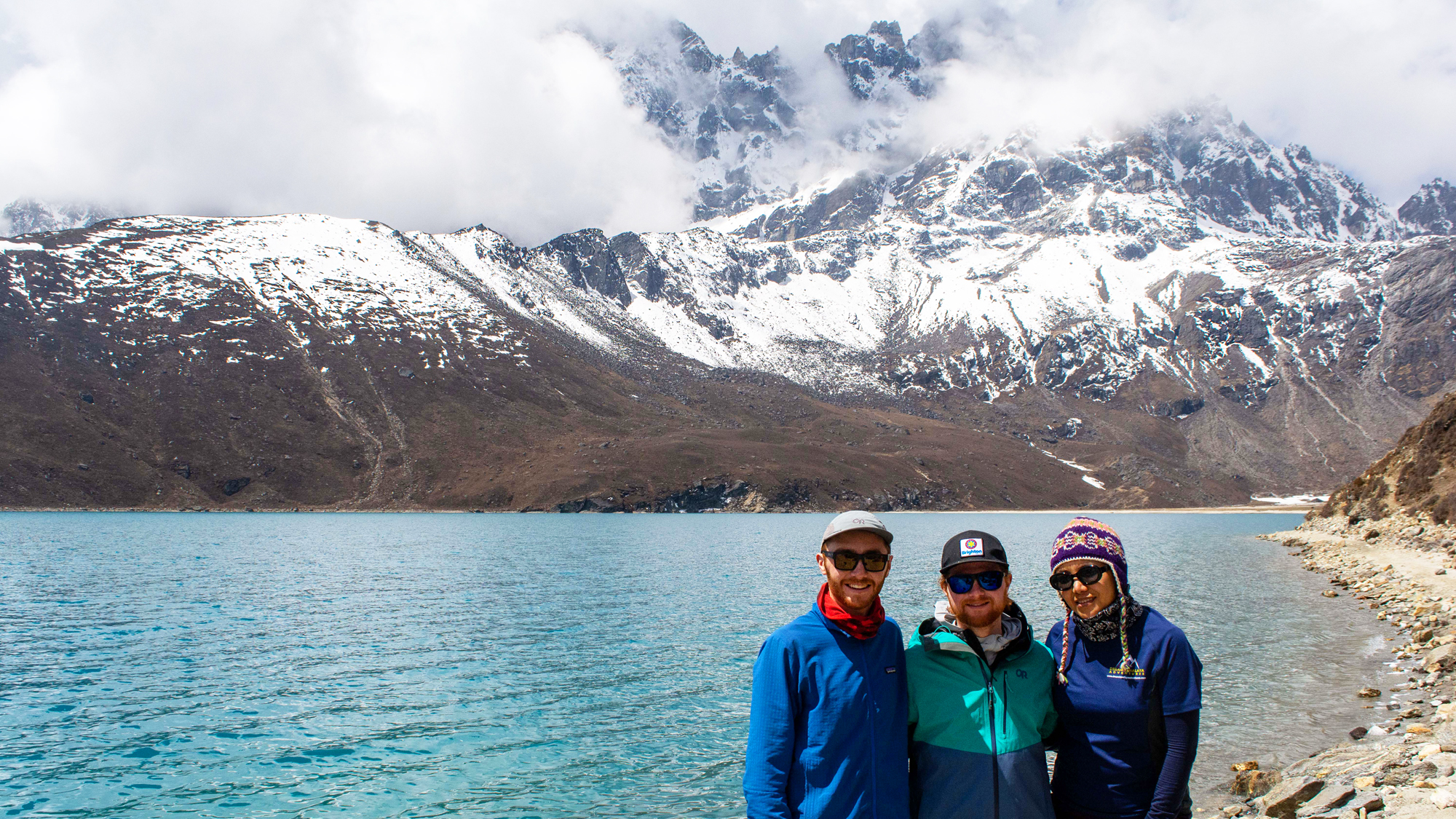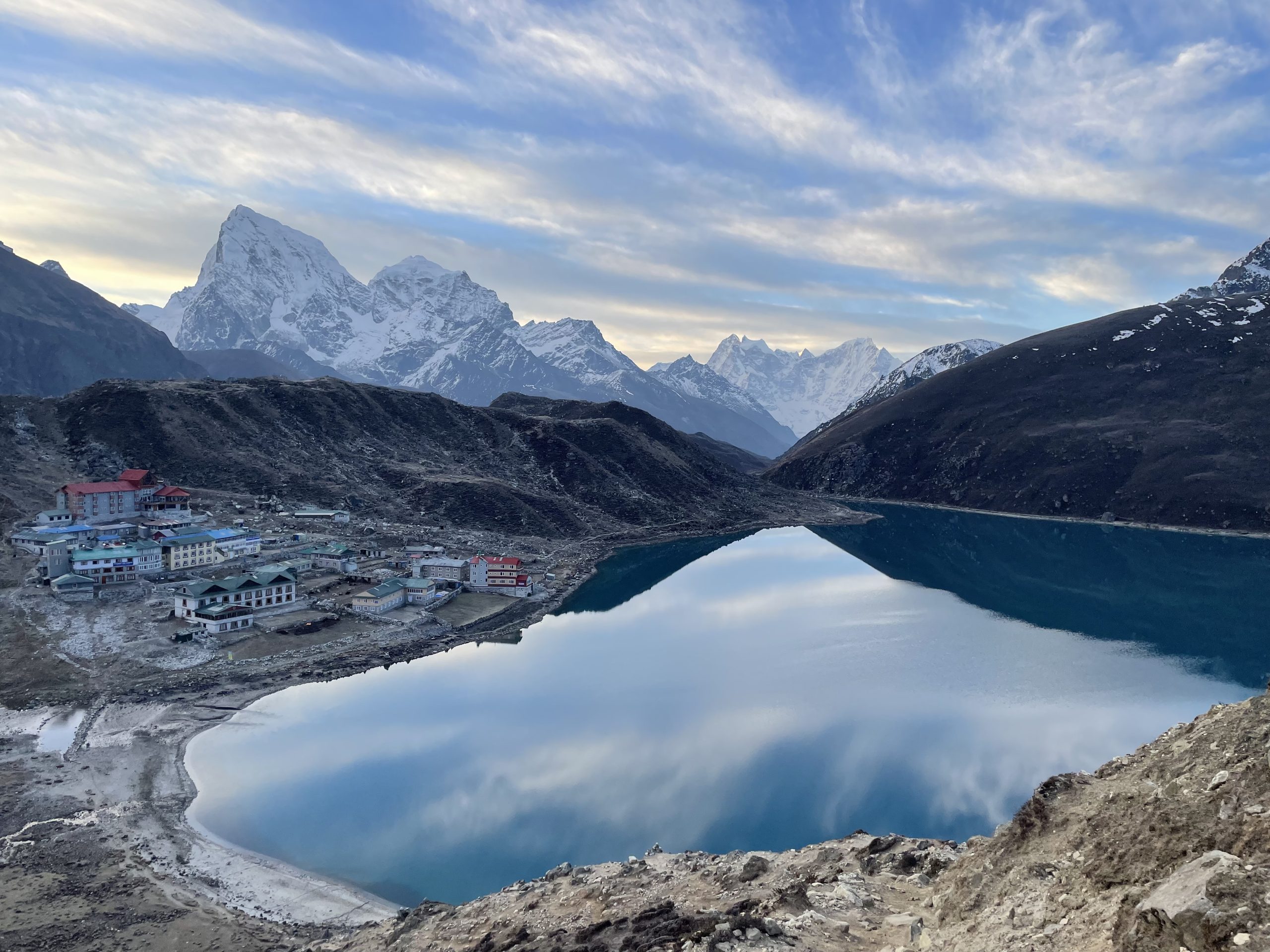

Environmental Science undergraduate student Declan Taylor and Geography graduate student Maicen Stewart join Dr. Pasang Yangjee Sherpa in Khumbu for a community consultation visit. Image was taken in front of Gokyo Lake in May 2023 and was provided by Dr. Sherpa.
As an Indigenous woman from the Himalayas, anthropologist Pasang Yangjee Sherpa learned to keep her expectations low in academic and research spaces. Now, she is internationally recognized for her invaluable contribution toward discussions on Indigeneity in the Himalayas and the human dimensions of climate change.
Dr. Sherpa, an Assistant Professor at UBC Department of Asian Studies and the Institute for Critical Indigenous Studies, is deeply committed to sustaining Sherpa culture and improving the environment in which they live. “Education plays a vital role in recognizing and understanding the challenges Indigenous communities face. It is important that we not only critically analyze the material we learn about but also critically engage with the educational systems that bring those materials to us. Whose knowledge is it? Why am I engaging with this knowledge?” she emphasizes.
Centering her work around community in the Mount Everest region of Nepal—who have been pioneers of sustainability since time immemorial—is rightly in contrast to mainstream practices that often prioritize Euro-Western and consumerist contexts.
“As a Sherpa woman, I don’t know who and what our people will be without healthy mountains. I don’t know how we will transmit our ancestral knowledge to the next generation without our language and our songs. These vital aspects of mountain lifeways never make it to the discussions concerning our future among authorities, largely because we are physically excluded or included only for symbolic reasons to check the box.”
Dr. Sherpa’s dedication to people-driven research, with a specialization in Indigenous communities in the Global South, led her to being a winner of the highly competitive Mellon Foundation New Directions Fellowship. She is the first UBC faculty member to receive such recognition for her proposal that aims to study the Himalayan geomorphology through an interdisciplinary lens. “It took me a while to process the news of being selected as a finalist. Honestly speaking, it will take me some more time to fully appreciate this special outcome. I think it will all sink in once I go back to my community in Pharak to see the impact on the ground,” she explains.
To better understand her work, we asked Dr. Sherpa about the vitality of Indigenous wisdom, its role in advancing the enduring aspirations of the marginalized communities, and the profound connection between community-building and its effects on initiatives addressing climate change.
Your proposal has a strong emphasis on cross-disciplinary training. Can you share why a cross-disciplinary lens, specifically including geography, is vital for your research focus?
I am invested in studying the impact of climate change on my community and neighboring Indigenous communities so that we are equipped with the knowledge required to sustain our peoples. I am also committed to ensuring that our communities are represented in spaces where our futures are being designed. My New Directions Fellowship proposal has a strong emphasis on cross-disciplinary training because the challenge we face today in a world experiencing climate crisis cannot be understood from a singular disciplinary lens.
In Nepal, for example, the conventional understanding of ‘sustainability,’ as the longevity of resources for continued extraction, dominates institutional planning and policies for climate adaptation. Indigenous Peoples and their relationships with the mountains, the lands, the lakes and the spirits that live in them are seldom part of the conversations about sustainable Himalayas.
The question I am motivated by in pursuing geography is: what more can I learn and do to work towards sustainability of our people?
How does this recognition affect your ongoing research on the cultures of Indigenous communities in the Himalayas and climate change?
As an assistant professor of Lifeways in Indigenous Asia, I have devoted my career to understanding and teaching about Indigenous transcontinental connections, informed by everyday climate change realities. With my research expanding across continents and oceans to further investigate contributions from Indigenous science to planetary health, I am drawn back to my roots in Khumbu to address the urgent question: What can Sherpa lifeways under changing cryospheric conditions in the last four hundred years teach humanity about its collective survival on the warming planet? We know that Sherpa villages in Khumbu (10,000ft – 15,000ft) on the southern slopes of Mount Everest were made possible by careful relational co-existence with the environment. The questions about how our ancestors survived the harsh terrain and made it liveable for all its residents, however, remain open. I am interested in answering these questions so scientists and policymakers across scales can be better equipped in designing just liveable futures for all.


Image of Gokyo Lake, next to the Ngozumpa Glacier (out of sight). Photo provided by Dr. Sherpa.
Given your focus on climate change and Indigeneity in your pedagogy, how do you incorporate and advocate for cultural representation in your teaching?
I ensure that the course is designed centering Indigenous vision, wisdom, and scholarship. I include Indigenous experiences from local, national, regional, and global scales to broaden students’ understanding of how deeply and widely climate change is present in the lives of Indigenous Peoples. I prioritize students’ health and wellbeing. I show students that community-building and relational approach to learning is key to living well with climate change.
How do you perceive the unique perspective that Indigenous communities bring to the discourse on climate change, and what role do you think they play in shaping climate policies and actions?
Speaking as an Indigenous scholar from the Himalayas who has experience with international climate assessment reports, I see Indigenous Peoples and Indigenous Knowledges being treated in two ways. First, their experiences are presented as examples of how Euro-Western science predicts things will unfold. Second, their knowledge is sought to supplement existing Euro-Western science. In both cases, Indigenous Peoples, their experiences and knowledges are not considered in their contexts. Instead, elements of relevance are picked based on their utility to advance mainstream climate policies and actions.
When talking about climate change with Indigenous thought leaders from around the world, it is common to hear them mention greed as the cause of climate change and relationship as the technology of survival. This suggests that our greed-driven over-consumption patterns need to be critically examined and that we need to harness the technology of relationship. This realization has encouraged me to end my talks on climate change with a prayer to the audience, which I would like to offer to the readers:
“When the fire burns, when the lake floods, when the earth cracks, and when the wind storms, I pray that there is someone to lend you a hand. Thuchiche!”


